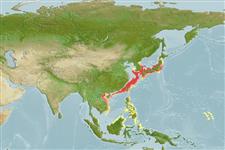Elasmobranchii (hajar och rockor) (sharks and rays) >
Torpediniformes (Electric rays) >
Narkidae (Sleeper rays)
Etymology: Crassinarke: Latin, crassus = fat, thick + Greek, narke = to narcotize (Ref. 45335).
Environment: milieu / climate zone / depth range / distribution range
Ekologi
marina bottenlevande; djupintervall 80 - ? m (Ref. 58018). Temperate
Western Pacific: southern Japan to the South China Sea.
Size / Vikt / Age
Maturity: Lm ? range ? - ? cm
Max length : 13.7 cm TL hane/ej könsbestämd; (Ref. 50165)
Life cycle and mating behavior
Könsmognad | Reproduktion | Lek | Ägg | Fecundity | Larver
Mould, B., 1994. A world list of rays. The scientific nomenclature and distribution of the recent Batoidea (Batoidea, Elasmobranchii, Chondrichthyes). University of Nottingham, [UK]. 82 p. (Ref. 8630)
IUCN Red List Status (Ref. 130435: Version 2024-1)
Threat to humans
Harmless
Human uses
Verktyg
Special reports
Download XML
Internet-källor
Estimates based on models
Preferred temperature (Ref.
123201): 15.6 - 21.8, mean 17.9 °C (based on 20 cells).
Phylogenetic diversity index (Ref.
82804): PD
50 = 1.0002 [Uniqueness, from 0.5 = low to 2.0 = high].
Bayesian length-weight: a=0.01000 (0.00244 - 0.04107), b=3.04 (2.81 - 3.27), in cm total length, based on all LWR estimates for this body shape (Ref.
93245).
Trofisk nivå (Ref.
69278): 3.2 ±0.3 se; based on size and trophs of closest relatives
Resiliens (Ref.
120179): Låg, lägsta populationsfördubblingstid 4,5-14 år (Assuming fecundity<100).
Fishing Vulnerability (Ref.
59153): Low vulnerability (10 of 100).
